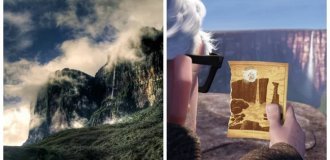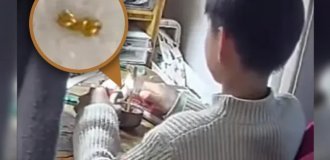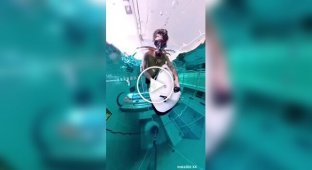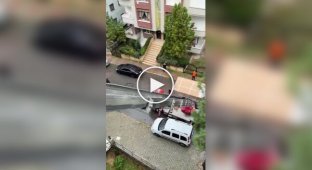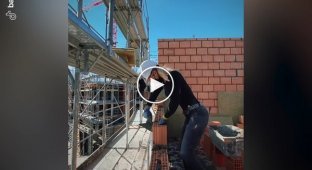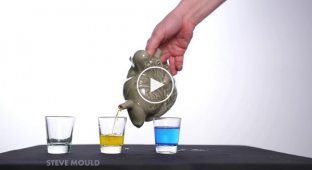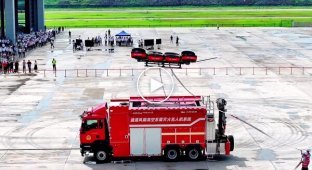Chernobyl. History of liquidation. Rare photographs. (33 photos)
Igor Kostin was born in 1936 in Moldova. The correspondent of the Ukrainian APN was the first to be at the epicenter of the accident on April 26, 1986. He was the only photojournalist who got close to the destroyed reactor. The photographs he managed to take were included in the official report of the government commission. His series “The Tragedy of Chernobyl” was awarded at the World Press Photo in Amsterdam.

This photo was taken at 16:00, 14 hours after the disaster. The photo was taken from the window of the first helicopter that flew around the epicenter of the disaster in order to measure the level of radiation. The exploded reactor appears slightly hazy due to the high levels of radiation, which also explains why the photo was taken through a closed window. Later, dosimetrists found out that the background radiation level was 1,500 roentgens per hour, although meters not designed for such a high level showed only 500 roentgens per hour.

Every day, starting from the first, helicopters made five sorties to clarify the situation prevailing in the destroyed reactor.

A dosimetrist measures the level of radiation activity in the fourth power unit. During the liquidation of the accident, 5,000 tons of various decontamination materials were dumped into the mouth of the reactor.

The destroyed fourth reactor was removed from the roof of the third power unit.

After evacuating the population from the village of Pripyat, liquidators wash away radioactive dust from the streets, trees and houses. The liquid that was poured over the entire contaminated area was called “burda.” This sticky substance nailed the radioactive dust to the ground and glued it together.

Every day, helicopters sprayed “burda” over the territory of the Chernobyl nuclear power plant. After the “burda” dried up, it was simply rolled up like a carpet and buried in radiation burial grounds. The liquid recipe was developed at the Institute of Atomic Physics by Academician Kurchatov.

Most of the liquidators were simple reservists, drafted into the Armed Forces to assist in the liquidation work, or employees of the RKhBZ troops. The armed forces were not equipped with appropriate uniforms designed to work in conditions of high radioactive contamination.

Those assigned to work in the most dangerous areas were dressed in their own uniforms or clothing, and the only protection was sewn lead plates 2-4 mm thick and simple respirators.

Rubber aprons were put on top.

Another batch of liquidators is preparing to go to the roof of the reactor.

Every minute a new batch of people came out onto the roof, who were practically in no way protected from radiation exposure.

Liquidators in homemade armor made of lead sheets go out in pairs to the roof of the third reactor in order to throw off radioactive debris.

The basic rule of the liquidators working on the roof of the power unit was “found, picked up, reported, dropped.” During those 40-60 seconds measured for work on the roof, nothing else could be done, and it was not required. One person - one piece of debris. And so hundreds of people in a row for a long time, until the entire roof of the nuclear power plant was cleared.

At first, it was planned to entrust German, Japanese and Russian robots to remove radioactive debris from the roof, but due to the high level of radiation, the electronics simply failed, then it was decided to use people for this work.

The glare from below in the photograph is the result of high levels of radiation. On the remains of the roof of the fourth reactor. People are raking up radioactive debris and throwing it down. Each visit lasted no more than 60 seconds, since staying on the roof for a longer time risked immediate death. Every 60 seconds, the sound of a howling siren was heard, which indicated the end of the next shift, after which new “biological robots” came out onto the roof.

The next group of liquidators is preparing to enter the radioactive roof of the fourth and third reactors. Fours emerging in pairs onto the roof
of that reactor were called “Petya” and “Vasya”. The basic rule of work is “found, picked up, brought, dropped.”

As a rule, each of those who removed debris from the roof climbed it only once, since the dose of radiation he received corresponded to that which an ordinary person receives in his entire life.

Two months after the explosion, it became possible to photograph the destruction from inside the destroyed power unit.

General Nikolai Tarakanov presents certificates of honor to the liquidators who worked on the roof of the reactor block. Doctor of Sciences Tarakanov was put in charge of the operation to clear the roof of radioactive debris in June 1986. The instructions he received said that all work on cleaning the roof must be completed before October 2, the time when M. Gorbachev was supposed to arrive at the station for a visit. Tarakanov tried to get more time for the operation, but he failed. To reduce the risk of infection among liquidators, he developed protective clothing for liquidators working on the roof. In 12 days, his team removed more than 170 tons of radioactive debris. Radiation levels on the roof ranged from 800 to 7000 microroentgen/hour.

“Roof Cats” - a group of liquidators on the roof of the third reactor block before hoisting a flag on the 78-meter chimney of the power plant.

The hoisting of the flag was supposed to indicate the completion of cleaning work on the roof. Following the instructions of their superiors and the requirements to mark the end of cleanup work on the roofs of the power units, three liquidators had to climb to the top of the ventilation pipe standing above the destroyed reactor. They had to walk 78 meters up the spiral staircase, constantly aware of the danger emanating from the destroyed power unit, and hoist a red flag.

Before them, this operation was attempted twice from a helicopter, but both times the operation was unsuccessful. The entire time allotted for hoisting the flag took 9 minutes, since a longer exposure to radiation of such strength could simply kill them. As a reward, at the end of the operation, the team of three who hoisted the flag on the pipe received a bottle of Pepsi-Cola and one day off.

Thousands of vehicles were used to eliminate the consequences of the accident. After liquidation, the most contaminated equipment, along with that which belonged to residents of the village of Pripyat, had to be buried in special burial grounds. Metal absorbs radiation very well, and today it has become clear that the decision to bury the equipment was wrong, since radiation is washed out by rainwater and goes deep into the earth. After which it penetrates into groundwater, with which it enters the Pripyat River basin.

Construction of the sarcophagus. The roof is laid on 27 steel beams, each 35 meters long. At first it was planned to lay the beams using helicopters. This idea was unsuccessful. Ultimately, remote-controlled cranes did the trick.

Bulldozers are raking up radioactive debris ejected by the explosion and thrown by liquidators from the roof into the area that will be hidden under the sarcophagus. 
Thousands of protected trucks were involved in the cleanup. After a week of use, they had to be buried in burial grounds, since the metal began to literally “glow” from radiation.

The third reactor, separated from the fourth only by a concrete wall, was put into operation on December 4, 1987. A station employee demonstrates the wall separating the reactors with the radiation level marked on it.

The third reactor only ceased operation when the entire plant was decommissioned on December 15, 2000. 10 years after the accident, Igor Kostin again goes deep into the fourth reactor.

On the left you can see the reactor lid thrown off by the explosion. The liquidators gave the lid the common name “Elena”. On the right in the wall there are holes drilled in which measuring instruments are located.

Forty meters below ground level is the epicenter of the explosion. The level of radiation is unbearable for humans and is equal to 2600 microroentgen/hour. This is Igor Kostin’s third visit to the destroyed reactor, so
how the photographs taken on the first two visits simply did not turn out well. The film was exposed to radiation.



Igor Kostin. Photographer. Igor Kostin has filmed more than five thousand documentary stories about the Chernobyl tragedy and its consequences. The only reporter in the world took pictures of the epicenter of the explosion. He received more than five maximum permissible doses of radiation and was treated for a long time in special radiation pathology clinics in Moscow, Kyiv, and Hiroshima. He has been awarded the highest international journalistic awards: “Golden Eye”, “Golden Amburcido”, Grand Prize of the National Association of Professional Reporters of the USA and others. The Washington Post called him a "legend."
photo© Igor Kostin/Sygma


